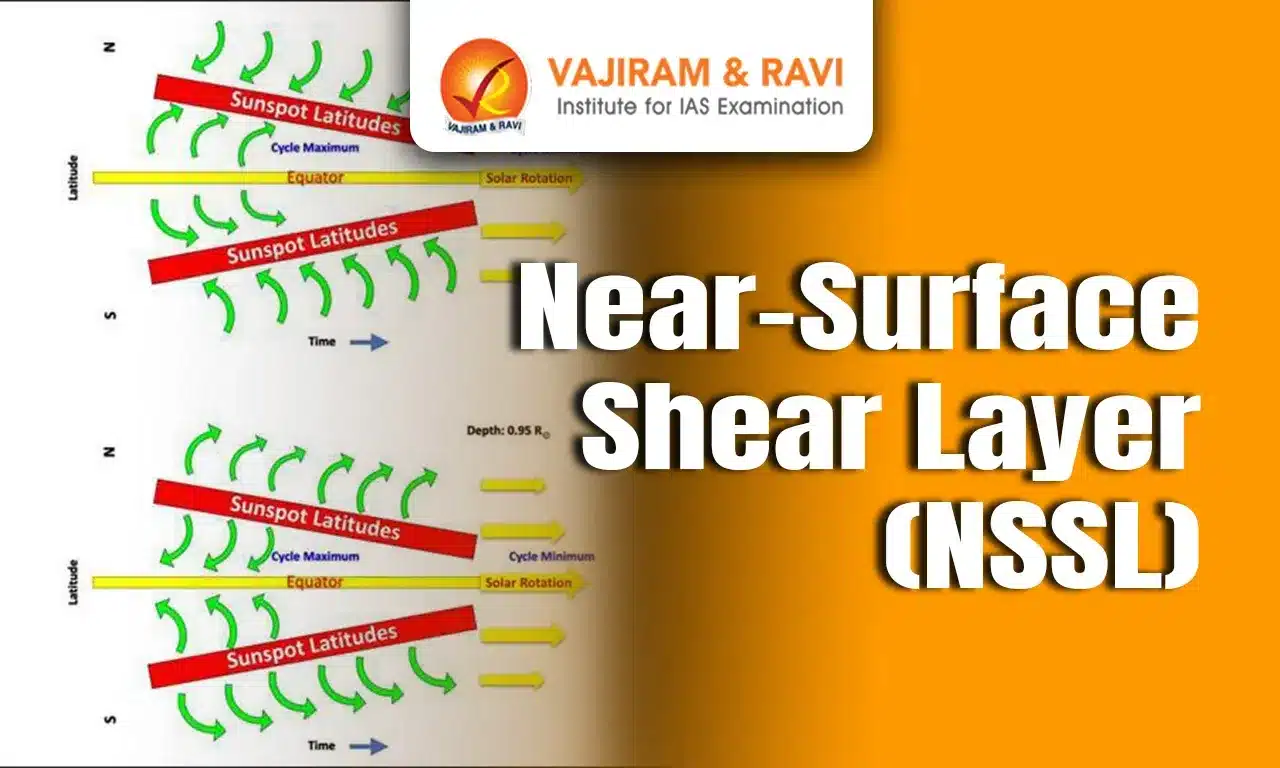Near-Surface Shear Layer (NSSL) Latest News
An international team of solar physicists, including scientists from the Indian Institute of Astrophysics (IIA), has mapped dynamic plasma currents in the Sun’s Near-Surface Shear Layer (NSSL), revealing patterns that correlate with the Sun’s 11-year magnetic activity (sunspot) cycle.
About Near-Surface Shear Layer (NSSL) & Key Findings
- The Near-Surface Shear Layer (NSSL) is a crucial region located just beneath the Sun’s visible surface, extending to a depth of about 35,000 km.
- In the NSSL, the Sun’s angular velocity (rotation speed) decreases rapidly with radius, creating a rotational shear that varies with depth, latitude, and solar magnetic activity.
- The study revealed surface plasma flows converge towards sunspot latitudes but reverse midway in the NSSL and flow outward, forming large circulation cells.
- These flows are shaped by the Sun’s rotation and the Coriolis force, which also influences Earth’s hurricanes. This connection helps explain how the Sun’s spin behaviour varies with depth.
- Despite being dynamic, these localised flows do not drive the Sun’s large-scale zonal flows, known as torsional oscillations, implying the presence of deeper unknown forces in the Sun’s interior.
Techniques Used
- Scientists employed helioseismology, a method that uses sound waves travelling inside the Sun to map internal structures and dynamics.
- They used over a decade’s worth of data from:
- NASA’s Solar Dynamics Observatory (SDO), specifically the Helioseismic and Magnetic Imager (HMI), and
- The Global Oscillations Network Group (GONG) of the National Solar Observatory (NSO), USA.
- The research confirmed the findings using 3D velocity maps of sunspot regions, showing matching surface inflows and deeper outflows.
Near-Surface Shear Layer (NSSL) FAQs
Q1. What is the Near-Surface Shear Layer (NSSL)?
Ans. NSSL is a thin zone beneath the Sun’s surface where the rotation rate of solar plasma changes rapidly with depth, affecting solar dynamics and sunspots.
Q2. Why is NSSL important in solar physics?
Ans. NSSL helps scientists understand solar magnetic fields, solar cycles, and space weather phenomena like solar flares.
Q3. Which mission has studied the NSSL recently?
Ans. The Solar Orbiter (ESA) and NASA’s Solar Dynamics Observatory have provided key data to study the NSSL.
Source: PIB
Last updated on December, 2025
→ Check out the latest UPSC Syllabus 2026 here.
→ Join Vajiram & Ravi’s Interview Guidance Programme for expert help to crack your final UPSC stage.
→ UPSC Mains Result 2025 is now out.
→ UPSC Notification 2026 is scheduled to be released on January 14, 2026.
→ UPSC Calendar 2026 is released on 15th May, 2025.
→ UPSC Prelims 2026 will be conducted on 24th May, 2026 & UPSC Mains 2026 will be conducted on 21st August 2026.
→ The UPSC Selection Process is of 3 stages-Prelims, Mains and Interview.
→ UPSC Result 2024 is released with latest UPSC Marksheet 2024. Check Now!
→ UPSC Toppers List 2024 is released now. Shakti Dubey is UPSC AIR 1 2024 Topper.
→ Also check Best IAS Coaching in Delhi
Tags: Near-Surface Shear Layer (NSSL) prelims pointers upsc prelims current affairs

















